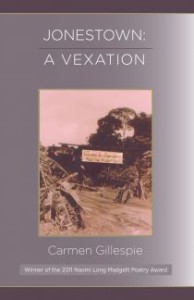 This year, 2011, marks the tenth anniversary of the September 11 events that resulted in the largest single-day loss of American civilian life in the history of our country. Memorializing loss and reflecting on its consequences and meanings is essential work and yet, too often, we have exercised a selectivity about what we choose to commemorate, what we choose to remember, and what we choose to forget.
This year, 2011, marks the tenth anniversary of the September 11 events that resulted in the largest single-day loss of American civilian life in the history of our country. Memorializing loss and reflecting on its consequences and meanings is essential work and yet, too often, we have exercised a selectivity about what we choose to commemorate, what we choose to remember, and what we choose to forget.
Last year, I published a book of poetry that was, in part, my attempt to grapple with the second largest single-day loss of American lives, the events that unfolded on November 18, 1978 in Jonestown, Guyana. Writing and publishing the book Jonestown: A Vexation was motivated in part by my perplexity at the relative erasure of the story of Jonestown from public history, in spite of its deep significances. The deaths at Jonestown include the assassination of Congressman Leo Ryan, the only US Representative in US history to be killed while serving in the line of duty. Peoples Temple and its leader, Jim Jones, were intimately associated with and, at least early in the history of the organization, endorsed by some of the leading social and political figures of the 1970s, and praised and supported at various times by people like Rosalynn Carter, George Moscone, Angela Davis, and Harvey Milk. In light of the Temple’s and Jones’s associations alone, it is hard to fathom how Jonestown could have been relegated to erasure and invisibility.
Most egregious, however, is our seeming ability to forget the almost 1000 Americans who died that day. One of the poems in my collection uses the geography of Guyana, with its alluvial plain that leads three major rivers to delta into the Caribbean sea, as a metaphor for this forgetting.
Alluvium
Recollection veins in rivulets,
its trace malleable,
fleeting as a flood plain—
an impressed hand upon the land,
with tawny tips dipped
and dissolving
in the sea.
The landscapes and histories of Guyana figure in my attempt to parse Jonestown. Guyana looms large in my memory, as it is a space where I lived during some of my coming-of-age years, which coincided with the years that the Temple relocated its major operations from San Francisco to Georgetown and then Jonestown, Guyana. I remember from that time two women coming to our home in Georgetown to talk about the Temple and to solicit donations, but we never really thought much about the visit until November of ‘78, after we had returned to the US and when Guyana and Peoples Temple had become news all around the world.
The coverage was marked by ubiquitous photographs taken from airplanes depicting hundreds of dead Temple members lying face down around the Jonestown pavilion. Part of my intention with my poetry was to try to move from the bodies in these iconic photos into the imagined subjectivities of those very real lives that were lost in that space. Ultimately, knowledge of those individuals and their loves, desires, and intentions is an unattainable proposition, except, perhaps, through art, which, it seems to me, allows us to begin to enter and, perhaps, limn the unrecoverable.
There, there was music
They left many things
back home, but their sounds
rocked to sleep, stowaways
in knot-holed trunks. Blinded
by the unrelenting light at journey’s
end, the displaced instruments
felt familiar fingers, heat-swollen
as forestfruit, and laughed.At dusk, electric gospel, soul,
funk, and blues inflated
the rubbery nights with measured
breath that rippled across skin
like the sometime breeze
from the sea.
It remains heart-breaking to see the footage of the people of Jonestown dancing to songs like Earth, Wind, and Fire’s “That’s The Way Of The World” at a celebration held on November 17th, the day before the mass deaths. That gathering of Temple members was held in an effort to convince Congressman Ryan that all was well at Jonestown—that the people in residence there were content and did not want to leave. Clearly, the story was much more complicated. If successful, my ruminations on Peoples Temple encourage those who read it to ask questions about those lives and the circumstances that surrounded them, all of which goes unconsidered and unremembered much too often.
A few days before September 11th this year, The New York Times ran an article about an elite gym located in Salt Lake City that is gaining a national following. The name of the facility is Gym Jones, a name which the owners, Mark and Lisa Twight feel embodies the club’s intensity. “We knew some people would call us a cult,” Ms. Twight said, “so we decided to own the joke.” Obviously, Jonestown and 9-11 are dissimilar in many ways, but the loss of humanity that is at the center of both of these events in American history warrants memorialization that is more than a joke or a flippant and disrespectful catchphrase like “drinking the Kool-aid.” I hope that Jonestown: A Vexation is a part of the work that many have undertaken to try to understand the deeply-rooted significances of Peoples Temple and to recall the lives and potentialities that were lost there with the respect and compassion they deserve.
There
On days without rain,
clouds, speeding to the sea, cast
caressing shadows.
(Carmen Gillespie was a Professor of English and the Director of the Griot Institute of Africana Studies at Bucknell University until her death on August 30, 2019. Further information on her book, Jonestown: A Vexation, may be found here. Her complete collection of writings for the jonestown report may be found here.)